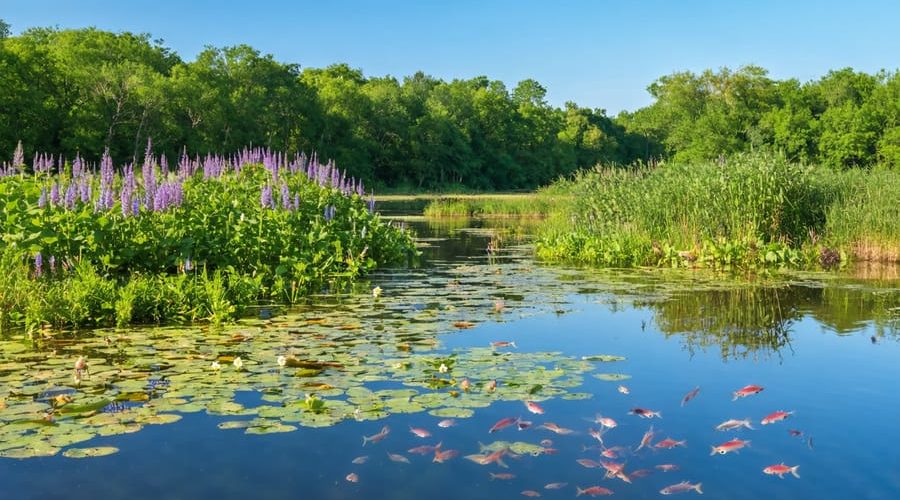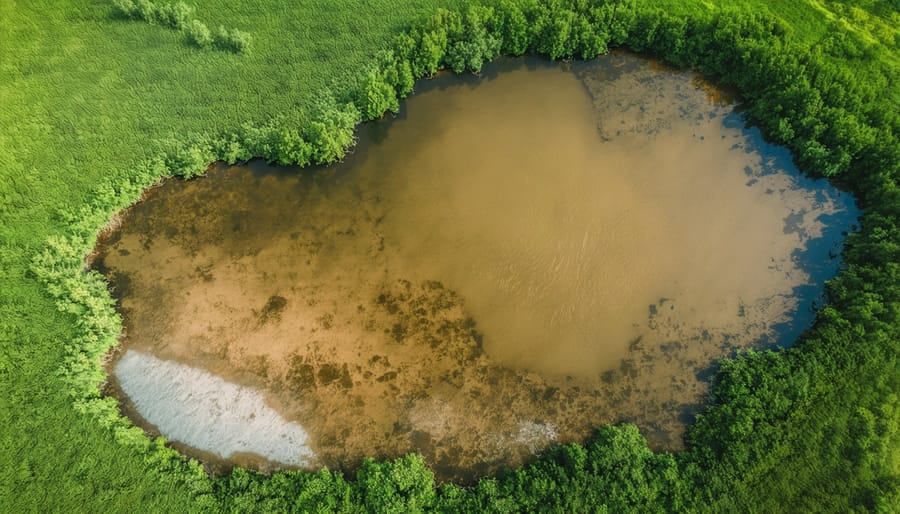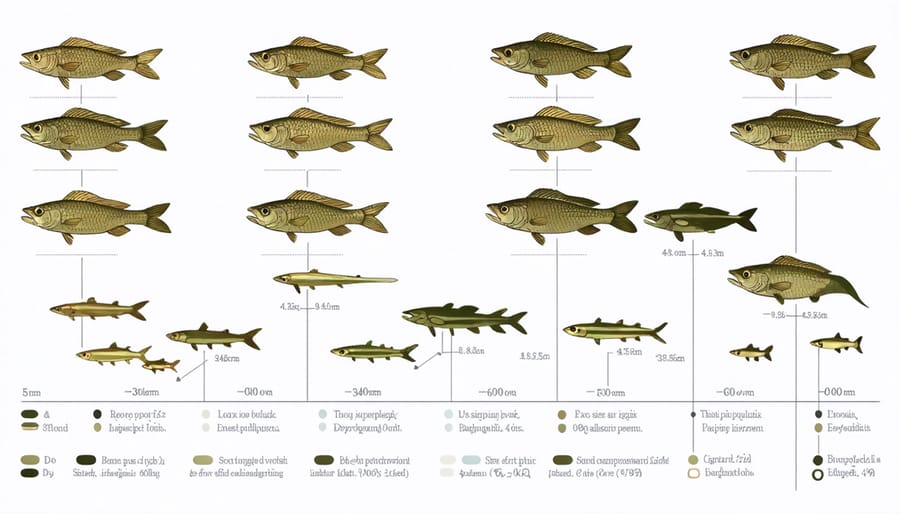
Transform Your Mississippi Pond into a Thriving Ecosystem
Managing a pond in Mississippi’s unique climate requires specific strategies to maintain optimal health and beauty. Start by testing water quality monthly, focusing on pH levels between 6.5-9.0 and dissolved oxygen above 5 ppm – essential parameters for our warm southern waters. Establish a balanced fish population with 100 bluegill per acre before introducing largemouth bass, creating a sustainable ecosystem that helps transform your garden pond into a thriving aquatic habitat. Control aquatic vegetation through integrated management: stock 10-15 grass carp per acre for biological control, maintain proper depths (at least 3 feet at edges), and implement strategic aeration systems to prevent stagnation during hot Mississippi summers. These foundational practices, tailored to our state’s specific environmental conditions, create the backbone of successful pond management that rewards owners with clear water, healthy fish populations, and reduced maintenance needs.

Understanding Your Mississippi Pond’s Ecosystem
Water Quality Essentials
Maintaining proper water quality is crucial for a healthy Mississippi pond. Regular testing should focus on five key parameters: dissolved oxygen, pH, alkalinity, ammonia, and temperature. During our hot summers, oxygen levels can drop dangerously low, especially in the early morning hours, so consider installing an aerator to maintain healthy levels above 5 ppm.
The ideal pH range for Mississippi ponds is between 6.5 and 9.0. Limestone applications can help stabilize acidic waters, which are common in our region. Alkalinity should be maintained above 20 ppm to buffer pH fluctuations and support healthy fish populations.
Test your pond’s water quality monthly during spring and summer, and bi-monthly during fall and winter. After heavy rains, additional testing is recommended as runoff can dramatically affect water parameters. Keep detailed records of your readings to spot trends and potential problems early.
Watch for signs of poor water quality, such as fish gasping at the surface, excessive algae growth, or unusual water color. These indicators often signal the need for immediate action to prevent fish kills and maintain a balanced ecosystem.
Native Species and Their Roles
Mississippi’s ponds naturally support a diverse ecosystem of beneficial species that work together in creating a natural oasis. Largemouth bass serve as the primary predator fish, helping control smaller fish populations, while bluegill and redear sunfish keep insect numbers in check. Native aquatic plants like water lilies and pickerelweed provide essential cover for fish and help maintain water quality by absorbing excess nutrients.
Beneficial microorganisms play a crucial role in breaking down organic matter and maintaining healthy water conditions. Dragonflies and damselflies are welcome visitors that help control mosquito populations, while freshwater mussels naturally filter the water. Along the shoreline, rushes and sedges prevent erosion and create vital habitats for frogs and turtles.
When stocking your pond, focus on maintaining a balanced ratio of predator to prey fish. A typical combination might include 100 bluegill per acre for every 50 largemouth bass, creating a self-sustaining ecosystem that requires minimal intervention.
Seasonal Management Strategies

Summer Heat Management
Managing pond temperatures during Mississippi’s sweltering summers is crucial for maintaining a healthy aquatic ecosystem. When water temperatures rise above 80°F, oxygen levels naturally decrease, putting stress on fish and encouraging excessive algae growth.
To combat these challenges, start by maintaining proper pond depth – at least 8-10 feet in some areas provides cooler zones where fish can retreat. Installing an aerator or fountain isn’t just decorative; it’s essential for increasing oxygen levels and creating water movement that helps regulate temperature.
For natural temperature control, strategically plant trees or install shade sails around your pond’s southern exposure. This provides cooling shade during the hottest parts of the day while still allowing morning sun. However, be mindful of falling leaves, which can affect water quality.
Algae control becomes especially important during summer months. Consider using beneficial bacteria treatments, which naturally compete with algae for nutrients. Aquatic plants like water lilies and lotus not only provide shade but also help reduce algae by consuming excess nutrients.
Monitor your pond early in the morning when oxygen levels are lowest. If you notice fish gasping at the surface, immediate action is needed. Adding a supplemental aerator or adjusting existing aeration can provide quick relief. During extreme heat waves, running aerators 24/7 helps maintain stable oxygen levels and keeps your pond ecosystem balanced.
Winter Preparation
As winter approaches in Mississippi, taking proper steps to prepare your pond for colder temperatures is crucial for protecting your aquatic ecosystem. While our winters are generally mild compared to northern states, occasional cold snaps can still impact pond life.
Start by checking your pond’s depth – deeper areas of at least 3-4 feet provide fish with warmer zones during cold spells. If needed, remove excess sediment before winter arrives. Trim back aquatic plants and remove dead vegetation to prevent decomposition that could reduce oxygen levels.
Consider installing a de-icer or aerator to maintain an opening in the ice if temperatures drop below freezing. This allows for proper gas exchange and helps prevent winter fish kills. However, avoid breaking ice manually, as this can create harmful shock waves that stress fish.
Monitor your fish feeding routine carefully. As temperatures drop below 50°F, fish metabolism slows significantly. Reduce feeding amounts and switch to cold-weather fish food when water temperatures fall below 60°F. Stop feeding completely when temperatures drop below 50°F.
Don’t forget to protect your pond equipment. Remove and clean pumps and filters, storing them in a dry place if you plan to shut down your system for winter. If keeping the system running, insulate exposed pipes to prevent freezing.
Remember, a well-prepared pond in fall leads to a healthier ecosystem when spring arrives.
Fish Stocking and Management
Species Selection
When stocking your Mississippi pond, largemouth bass and bluegill make an excellent combination, forming the backbone of a sustainable fishing pond. These species thrive in our warm climate and create a natural predator-prey balance. For added variety, consider channel catfish, which adapt well to pond environments and provide excellent angling opportunities.
Redear sunfish (also known as shellcrackers) are another great choice, helping control snails and other small aquatic organisms. If your pond is at least 8 feet deep, you might also consider crappie, though they require careful management to prevent overcrowding.
For forage fish, fathead minnows and threadfin shad can help support your game fish population. However, avoid introducing common carp or bullhead catfish, as these can disturb bottom sediments and affect water quality.
When stocking, follow these ratios for best results:
– 100 bluegill per acre
– 50 largemouth bass per acre
– 100 channel catfish per acre
– 100 redear sunfish per acre (optional)
Remember that proper species selection is crucial for long-term success. Start with fingerling-sized fish in the fall, allowing them to establish themselves before the next growing season. This timing gives your fish the best chance of survival and helps create a balanced ecosystem.

Population Balance
Maintaining the right balance of fish populations is crucial for a healthy Mississippi pond. The general rule of thumb is to stock 100 bluegill per acre for every 10 bass. This ratio helps prevent overcrowding while ensuring enough forage fish for your bass population.
For optimal growth, feed your fish regularly during warm months (March through October) when water temperatures exceed 65°F. Offer fish food at the same time and location each day, providing only what they can consume within 15 minutes. A good starting point is 3-5 pounds of feed per acre per day, adjusting based on consumption.
Monitor your fish population through regular sampling and observation. Signs of an imbalanced population include stunted growth, excessive small fish, or a decline in catch rates. If you notice these issues, consider selective harvesting to restore balance. Remove smaller bass (under 14 inches) and harvest bluegill regularly to prevent overpopulation.
For larger ponds, adding threadfin shad can provide additional forage. However, this should only be done in ponds larger than 5 acres to maintain sustainable populations. Remember that achieving the perfect balance takes time and regular monitoring, but the effort pays off in a thriving pond ecosystem.
Vegetation Control and Enhancement
Beneficial Plants
Adding native aquatic plants to your Mississippi pond not only enhances its beauty but also promotes a healthy ecosystem. Through proper vegetation management, you can create a thriving habitat for fish and wildlife.
Consider incorporating water lilies, which provide shade and shelter while adding stunning blooms to your pond. Native species like American White Water Lily work particularly well in Mississippi’s climate. Pickerelweed, with its vibrant purple flowers, helps prevent erosion along the shoreline and provides excellent cover for small fish.
Arrow Arum and Duck Potato are excellent choices for shallow areas, offering natural filtration and wildlife food sources. For deeper zones, consider Watershield, which helps control algae by limiting sunlight penetration. Soft-stem Bulrush and Common Rush work wonderfully in the marginal areas, creating natural barriers that prevent soil erosion.
Remember to plant in clusters and maintain about 20-30% coverage of your pond’s surface area. This balance ensures enough open water while providing necessary habitat benefits.
Weed Management
Weed management is a crucial aspect of maintaining a healthy Mississippi pond. Both underwater and floating weeds can quickly take over if left unchecked, affecting fish populations and water quality. For small ponds, manual removal using rakes or nets can be effective for floating weeds like duckweed and watermeal. However, larger infestations may require herbicide treatments.
When using herbicides, timing is everything. Early spring applications, when weeds are actively growing but still small, typically yield the best results. Always identify the specific weed species before treatment, as different herbicides target different plants. Common problematic weeds in Mississippi ponds include hydrilla, water primrose, and alligatorweed.
Prevention is often easier than treatment. Maintaining proper water depth (at least 3 feet near the edges) and installing weed barriers in shallow areas can discourage weed growth. Regular monitoring helps catch problems early. Consider introducing sterile grass carp as a biological control method – they’re excellent at managing submerged vegetation, though you’ll need a permit from Mississippi wildlife authorities.
Remember to treat only one-third of your pond at a time when using herbicides to prevent oxygen depletion from decomposing vegetation.
Common Problems and Solutions
Water Quality Issues
In Mississippi’s unique climate, pond owners often face several water quality challenges that require regular monitoring and management. Common issues include high algae growth during warm months, excessive turbidity after heavy rains, and fluctuating pH levels. These problems can impact fish health and overall pond aesthetics if not properly addressed.
For successful balanced ecosystem maintenance, start by testing your water regularly. Key parameters to monitor include dissolved oxygen, pH, ammonia, and phosphorus levels. During summer months, when temperatures soar, oxygen levels can drop dramatically, especially in the early morning hours.
To combat these issues, consider implementing aeration systems, which help maintain healthy oxygen levels and reduce algae growth. Adding beneficial bacteria can help break down organic matter and reduce nutrient loads that feed unwanted algae. For muddy water, consider installing vegetative buffers around the pond to reduce erosion and sediment runoff.
Chemical treatments should be used sparingly and only after proper water testing. Remember that prevention through regular maintenance is often more effective than reactive treatments. If you notice unusual fish behavior or sudden changes in water color, act promptly to identify and address the underlying cause.
Wildlife Management
Managing wildlife around your Mississippi pond requires a balanced approach that benefits both the ecosystem and your property. While some wildlife adds charm and helps maintain a healthy pond environment, others can cause damage or become nuisances if left unchecked.
Beavers and nutria often pose the biggest challenges, as they can damage banks and vegetation. Installing protective wire mesh around valuable trees and maintaining steeper bank slopes can discourage their settlement. For muskrats, regular bank inspection and repair of burrow holes helps prevent structural damage.
Waterfowl, particularly geese, can become problematic when present in large numbers. Their droppings increase nutrient levels and can affect water quality. Installing simple deterrents like floating lines or reflective tape can help manage their presence without causing harm.
On the beneficial side, encouraging native species like turtles and frogs helps maintain natural pest control. Installing wood duck boxes and creating wildlife-friendly zones away from high-traffic areas allows you to enjoy wildlife while minimizing conflicts.
Remember that total wildlife elimination isn’t the goal – it’s about finding the right balance. If serious wildlife issues persist, consult with local wildlife authorities who can provide specific guidance for your situation. They’re familiar with Mississippi’s regulations and can recommend appropriate management strategies.
Successful pond management in Mississippi requires a balanced approach combining regular maintenance, water quality monitoring, and ecosystem awareness. By following the key practices we’ve discussed – from proper aeration and vegetation control to fish population management and erosion prevention – you can create and maintain a thriving pond ecosystem. Remember to conduct seasonal assessments, maintain proper documentation, and adjust your management strategies based on your pond’s specific needs and challenges. Whether you’re managing a recreational fishing pond or a decorative water feature, the effort you invest in proper maintenance will reward you with a healthy, beautiful pond that enhances your property for years to come. Stay proactive, be patient, and don’t hesitate to seek expert advice when needed. With dedication and consistent care, your Mississippi pond can become a valuable asset to your property and local environment.
